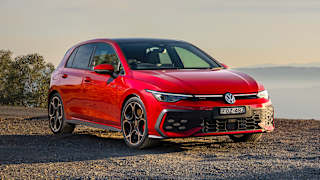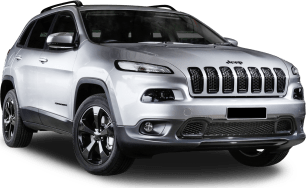There’s a lot of familiarity with this new Tiguan. It doesn’t stray far from the sturdy, boxy, but pragmatic shape of the current car, at least at a distance.
Up closer, though, it’s clear there are some significant changes this time around. The previous car’s hard and angular character lines have been replaced by curvy finishes over the top of the wheel arches, paired with heavier contours down the doors and across the nose.
The face has dumped the previous chrome highlights, moving the grille lower and replacing the horizontal strips which used to sit behind the VW badge with a solid plastic bar (incorporating an LED light) running across the top.
The grille has been moved lower, and chrome has largely been replaced with gloss black and matt silver finishes. While the outgoing car was attractive in a relatively conservative way this new Tiguan makes more of a statement.
Round the back, expect a similar contemporary translucent plastic light-bar treatment to marry the rear two light fittings, with the VW badge taking pride of place alongside the TIGUAN typeface, as is the current trend.
Design elements carried over in the rear three-quarter include the shape of the rear side windows, the tough extruded bumper and the little roof-mounted spoiler. Trendy aerodynamically-styled wheel choices round out its modern appeal.
Perhaps the strangest thing about this design is how it somehow manages to make the Tiguan look smaller where most next-gen designs make new cars look much larger than their predecessors. There’s something subtle about it.
Inside is a radical departure from the now significantly dated outgoing vehicle. The somewhat drab greyscale dash, which was also strangely upright, has been replaced by something much more intriguing.
A huge piano black panel defines the character line of the dash, housing the air vents, dashboard, and new ambient lighting, sitting behind the enormous pride-of-place 15-inch media screen.
VW clearly heard the audience and for this car has put a major focus on tech. The new software to match looks much better, the screen is sharp and fast, and as usual the brand’s digital dash is easily one of the best on the market.
Swapping out old switchgear has also allowed for a more contemporary, pared-back centre console with the nicely-designed steering wheel carrying across. EV-like controls from the ID series take their place on the steering column.
This is not a car you can judge from several metres away. This is a car that's been well and truly launched into the 2020s.












.png)












































.png)























 copy.png)
















